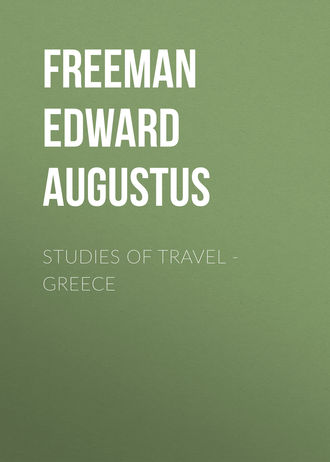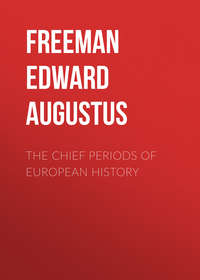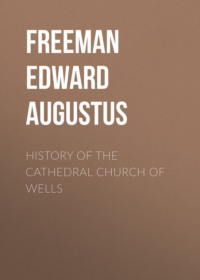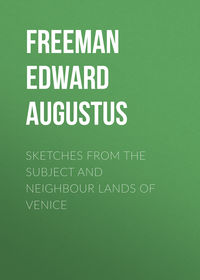 полная версия
полная версияStudies of Travel - Greece
The Akropolis of Mykênê
Euripides was perhaps after all not so far wrong as he seemed to the mocking genius of comedy, when he raised the question whether life and death were not in truth things which had exchanged their names:
τίς οἶδεν εἰ τὸ ζῆν πέν ἐστι κατθανεῖν, τὸ κατθανεῖν δέ ζῆν;It is at least very often so in the case of cities; it is emphatically so in the case of the great cities of the Argolic land. Argos, as we have seen, if it has not altogether died, has at least been brought down to a kind of life which, judged by its ancient standard, might pass for little better than death. Its continued being has destroyed well nigh every trace of its ancient state within the circuit which still remains inhabited. Argos is thus dead because it has lived. Mykênê, on the other hand, has remained alive because it died. Had Mykênê remained a ruling city, or even a dwelling-place of men in any shape, during all the ages which have passed since the fifth century before Christ, we should not see, as we now see, what the imperial city of the Pelopid house really was. Thanks to its happy destruction, no work of Turk, or Venetian, or Roman has ever arisen to jar on the associations of the primæval city. Even the works of those whom at Mykênê we must call the later Greeks, the men who dwelled there from the Dorian invasion to the days of Periklês, have passed away as though they had never been. No columns rise, as at Nemea, over the forsaken spot; we meet no tomb by the wayside, no legend graven on the rock, such as we light on as we tread the holy way from Athens to Eleusis. House and wall, temple and tower, were either utterly swept away by Argive wrath, or else they have crumbled away into nothingness since the scourge of Argos passed over the devoted city. Where once stood the wide streets of Mykênê, we meet only the shepherd with his crook to guide his flock, or the peasant woman, with Paionian industry, plying her distaff as she gathers her sheep or her goats to watering. For the hum of assembled citizens in the agorê, for the tramp of gathering warriors on the akropolis, we hear only the pipe of the shepherd himself and the bark of the shepherd’s dog. The shepherds who wander over the site of Mykênê may not wholly answer to the pictures of Theokritos or Virgil, but the crook, the pipe, the distaff, are here no figures of speech. They may be seen and heard daily as the sun rises over the deep gorge which fences in the Mykênaian akropolis, or when he “reigns” at eve over the heights of Artemis and Kronos. But even those few shepherds do not, like the few inhabitants of modern Corinth, dwell on the old site of Mykênê, nor do they profess to carry on the Mykênaian name. At the foot of the lower hill, the hill of the city as distinguished from the hill of the akropolis, a small church and a few houses, seeming almost to grow out of the rocky soil, form the small village, not of Mykênê but of Chorbati. Yet in one sense Chorbati has become Mykênê. Gathered there in a small museum are the less splendid and precious of the relics which modern discovery has brought to light on Mykênaian soil. And there too is one relic, torn from a rifled tomb on the akropolis, which to the eye of faith must be more precious even than the treasury and the lion-gate. There lies the nearly perfect skeleton which those who have trodden doubts and difficulties under their feet believe to be the very bones of Agamemnôn. The more cautious Greek antiquary is less rash in committing himself. Mr. Stamatâkês, the learned and zealous guardian of the Mykênaian treasury, points to it with a wise qualification. The rest of his explanation is given in the tongue which is alike his own and Homer’s. But, to express his doubts, the Hellenic lips have learned to form a Teutonic genitive. He does not commit himself to the belief that they are the bones of “Agamemnôn,” pure and simple; they are the bones of “Schliemann’s Agamemnôn.” Yet primæval Hellas, primæval Mykênê, has a history which may well live through alike unreasonable doubts and undiscerning faith. Call him what we will — Agamemnôn or anything else — the name matters little. It is a marked moment in one’s life when one looks on the bones of one who, we need not doubt, was, in days long before Hekataios wrote or even before Homer sang, a lord of many islands and of all Argos.
The position of the akropolis at Mykênê differs widely from that of either of the neighbouring akropoleis of Tiryns and Argos. The hill of Tiryns is a mere mound in the plain. The loftier hill of Argos, though far outtopped by the mountains behind it, still stands out as a marked object. But the akropolis of Mykênê, though we find it to be in a manner isolated, when we come to it, seems like an outpost of the far loftier hills immediately behind it. On one side the rock rises precipitously above a narrow gorge whose limestone cliffs at once, to an eye familiar with the West of England, suggest the gorges of Mendip, and, above all, the great pass of Cheddar. In the early days of fortifications, when there was no missile to be feared but darts and arrows, a fortress was not deemed to be in greater danger by reason of being thus overlooked. Indeed, to be overlooked by high and inaccessible mountains was in itself a kind of shelter. The Mykênaian akropolis thus stands upon the rocks and among the hills in a way in which its fellows at Tiryns and Argos do not. For that same reason it does not stand out in the same way as an object in the distant view. Its true form and position grow gradually upon us as we rise from the modern village along the paths — paths only of the shepherd and his flock — which are now all that represent the wide streets of the city beloved of Hêrê. More than one path may be chosen, and each will lead by one or more of the wonderful remains of the city itself, the so-called treasuries, as distinguished from the remains of the akropolis. But the path to be taken by choice, as it is the path to which the traveller’s instinct will most likely lead him, is that most to the right, that which skirts the brook which runs down from the limestone gorge, and which will lead his steps by the greatest monuments of all, the first and the second treasuries. But let the treasuries wait for a moment; they are works, though of unrecorded days, yet still of days far later than the defences of the akropolis itself. We will gaze first at the very centre of all, the centre, we may say, of præ-historic Hellas. And, as we draw near, we cannot help having our wrath slightly kindled against the last discoverer of Mykênê. Dr. Schliemann has done well in what he has brought to light; we cannot think that he has done well in what he has hidden. As we draw near, the height and outline of a great part of the outer wall of the akropolis are utterly hidden, the general view is spoiled, the proportion of the whole work is sadly damaged, because Dr. Schliemann chose to throw the rubbish which he dug out of the tombs anywhere where it might light. He has for the most part thrown it in vast heaps over the wall, by which a really large part of the course of the wall is hidden, and the whole view blurred and confused. A little trouble might have avoided this at first; a little more trouble might get rid of the rubbish now. In the last diggings at Athens much more care has been taken. The rubbish has been all carried away, and is piled in heaps where it does no harm. If in times to come those heaps should grow into hills like the “mons testaceus” at Rome, no harm will have been done, and an odd little piece of history will have been made. But Dr. Schliemann’s heaps of rubbish do seriously mar the general effect of the Mykênaian akropolis. They make it hard to understand the real line of the walls until we come quite close to them. Among the rocks and the walls, the walls growing out of the rocks, we see something which is neither rock nor wall, but which confuses the outline of both; as we come nearer, we find it to be the former contents of the royal tombs and of the other works which have been brought to light within the walls. As at Tiryns, there is a higher and a lower, an inner and an outer fortress within the akropolis itself. But the greater height of the Mykênaian hill makes this arrangement far more prominent, far more effective than it is at Tiryns. Only at Mykênê the lower enclosure has more of the air of an excrescence or an appendage than the lower enclosure of Tiryns. But it is this lower enclosure, the enclosure immediately entered by the famous lion-gate, which, whether an addition or not to the fortress above, has become the great centre of the associations of the place. There lie the empty tombs, thence came the wondrous treasures, which have carried us back into the depths of what we may fairly call præ-historic history, which have made us stand face to face, if not with the personal heroes of Homer, at least with the men of that age of Hellenic culture which the songs of Homer set before us.
The buildings of Mykênê have been described over and over again till their general effect must be almost as familiar to those who have not seen them as to those who have. But here, as everywhere else, it is the merely artistic character which can be thus taken at a distance. To feel Mykênê, as to feel any other place, we must see it. And even some of the artistic points can, as usual, be thoroughly made out only on the spot. One must see the place thoroughly to take in the wide difference between the masonry and artistic finish of the lion-gate and of the two chief treasuries. The lion-gate — we mean the gate itself, as distinguished from the lions — is a mere piling together of stones. The work is done doubtless with great mechanical skill, and it has the wonderful effect which all such primitive buildings have; still it is altogether without any claims on the score of art. But in the gateways of the treasuries, instead of the vast erect jambs of the lion-gate, we find well-wrought courses of stone in two orders, with something that may almost be called a moulding. These gateways had columns too. Unluckily nearly all are gone, even the precious fragment which was seen and drawn by the earlier travellers. This last, be it remembered, was of a kind which would not have looked out of place in any Romanesque building in England or Normandy. This is a most instructive fact, as the likeness must have been purely accidental; and this may serve to remind us that there are such things as accidental likenesses, and to warn us against leaping to conclusions when such likenesses are found in times and places far distant from one another. In the second treasury, the one lately brought to light by Dr. Schliemann, there is a fragment of another column, no longer in its place, which looks like the first rude attempt at the later Doric. Now over both these gateways, and also over the lion-gate, are openings of the same triangular form, though of course wrought far more carefully in the treasuries than in the lion-gate. In the treasuries these openings are openings; they are at present filled up with nothing. That over the lion-gate is filled, as all the world knows, with a basaltic stone which would seem more natural at Bamburgh than at Mykênê, carved with the famous lions, if lions they be, which guard a column that would not seem out of place in the duomo of Fiesole, in the apse of La Couture at Le Mans, or even in the slype at Worcester. Can we believe that the lion-gate and the lions, that the lion-gate and the gates of the treasuries, are all of the same date? And in point of work the lions at once connect themselves with the gateways of the treasuries, not with the gateway over which they stand. Surely we have in these gateways signs of an abiding type which lived on through several stages of advancing art. Over the square-headed gate there was to be, for whatever reason, a triangular hole, doubtless meant to be filled with a stone of its own shape. In the treasuries either this stone was never put in or it is gone. In the lion-gate it was put in, as it seems to us, when art had passed the stage represented by the lion-gate itself, and had reached the stage which is represented by the gateways of the treasuries.
Another thought suggests itself. At Mykênê, as less clearly at Tiryns, the lion-gate, with its skilfully guarded approach, does not lead at once into the higher enclosure of the akropolis, but into the outer and lower one. Does this go at all to show that this outer enclosure, at Mykênê at least, was an addition to the primitive fortress of all, fencing in the upper part of the hill? The fact that the tombs were found in the lower enclosure also looks this way. There must have been a time when this ground was looked upon as being outside the city, or it would hardly have been used for purposes of burial. The argument does not quite reach demonstration; burial within the walls was not absolutely unknown even in historical Greece, and it may not be safe to argue from historical to primæval Greece. Still the two arguments so far fall together as at least to suggest the idea that we have in the inner enclosure something yet more ancient and venerable than all — something which may have been ancient and venerable, not only in the days of Homer, but in the days of those whose tale Homer has told.
For the present we keep within the akropolis, within the old hill fort which forms the inner circle of the Ekbatana of the imperial lords of præ-historic Hellas. We stand here within the walls which struck the minds of so many of the poets of Greece in the days when their desolation was a thing of yesterday — walls which seemed too mighty to be the work of mortal men, and which, like their fellows elsewhere, were deemed to have been wrought by the same hands which forged the thunderbolts of Zeus. Here we may in truth
Φάσκειν Μυκήνας τὰς πολυχρύσους ὁρᾷν, πολύφθορόν τε δῶμα Πελοπιδῶν τόδε —
and we may deem that the house of the Pelopids was something which grew up as a new thing beneath the shadow of the Cyclopean walls. That inner fortress may well be to the Mykênaian empire of Homeric times what Roma Quadrata on the Capitol was to the Rome which bore rule over all Italy. But not a word is there in the Homeric tale to make us think that that empire was a dominion of foreign princes, or that the patriarch of the Pelopids was other than a son of the peninsula to which the race gave its name. From the akropolis one may look down on the enclosure which holds the rifled tombs, on the space beyond — the site of the wide streets of Mykênê — which holds the treasuries, and so on to destroying Argos and to Tiryns, the fellow-sufferer in overthrow. There is no other spot where we are carried so deep into unrecorded ages, and where unrecorded ages tell their tale so clearly. But the tale of the akropolis, even the tale of the inner fortress, is enough for one while. The tombs of the lower enclosure, the treasuries, if treasuries they be, of the outer city, may supply their own materials for separate thought.
The Treasuries and Treasures of Mykênê
The Treasuries of Mykênê we have heard of all our days; the Treasures have become famous only since the diggings of Dr. Schliemann brought them to light. The names are perhaps unlucky; as, to those who have not seen the spot, they may suggest a connexion between the treasuries and the treasures which does not exist in fact. The treasures were not found in the treasuries, nor even in the same part of the city as the treasuries. The treasures come from the tombs, and all the tombs that have been opened lie in the outer and lower enclosures of the akropolis. The treasuries, one of which has long been famous, lie altogether outside the akropolis, in what must have been the outer city, among the wide streets of Mykênê. The word “treasures” again may suggest a false idea. Objects thrown into tombs as part of the honour done to deceased persons are hardly “treasures” in any ordinary sense of the word. A treasure is something which may be drawn upon for use; objects which are thrown into tombs are, in the nature of the case, never meant to be used again. But, by whatever name they are to be called, there they are; remains of a great age, of an age which, though beyond the reach of chronology, we can hardly call unrecorded. Though the great works of Mykênê are manifestly of various dates, yet all may in a general way be said to belong to one period — the period, whatever its length, whatever its distance from ourselves, when Mykênê was the head of Hellas. To some stage of that period the objects found in the tombs must belong. It is enough to say that they are work of the period which Homer had before his eyes when he sang of the transfer of the sceptre through the successive generations of the house of Pelops, no stranger house in his song. To attempt to assign the tombs, the skeletons, the ornaments, to particular persons is rash. And, on the other hand, the time is hardly come for those who take a general view of history to commit themselves to any decided judgment as to the place which these objects have in the history of art, or as to their relation to objects found in other lands. It is well that the specialists should for a little time longer have that branch of the subject in their keeping. Some new light will doubtless be thrown on the matter by the find which has just been made in Attica. When all these points have been thoroughly sifted, the historian will be glad to accept the results. As it is, it is enough for him that here are the tombs of the Mykênaian lords of Hellas, that here are the objects which the creed of their days deemed becoming offerings of reverence for the dead.
Besides the field which these objects open for the more direct student of art, they open also a field of almost higher interest for the historian of customs. The mode of disposing of the dead seems to have been a strange kind of compromise between burning and burying. If we rightly understand the process, the bodies were placed in the tombs; they were then half burned; lastly the masks were placed upon them, and the tombs were filled up with the vases and other objects. Here indeed is work for Mr. Tylor and any other labourers in that field. The effect of the masks is wonderful. Whether they are really likenesses or not, we accept them as such while we look on them; we feel ourselves brought more directly into the presence of the men of old than we are even by the sight of the skeleton. Physically the actual bones of the man are more truly part of himself; but we really feel brought nearer to him as we see the thin covering which has rested on his face, and which seems at least to profess to keep the stamp of his features. We will not dare to call him Agamemnôn or any other name. We look at least on what would be the likeness of one of those on whom our own Alfred so happily bestowed the name of the Cæsars that were to be, on one whose historic position is best brought home to us if we call him, in Alfred’s tongue, the Bretwalda of primæval Hellas.
The ornaments and other objects have been described and discussed over and over again by those who have a special object in their study. But there is one among them which we do not remember to have seen described in any of the published accounts, one which, if it has been already mentioned, will certainly stand being mentioned again. Of all the objects which Mr. Stamatâkês has under his care, and which he so fully and clearly explains to all who can follow him in his own tongue, there is none more curious in itself, none which speaks more directly home to us, than those pieces of thin gilding which were found in one of the tombs over the breast of one of the female bodies, and which, when put together, were found to make the complete figure of a young babe. There is nothing wonderful in this. A royal infant — a clitunculus, as some of our own chroniclers would have called him — may have died at Mykênê and have been buried with his mother, as well as anywhere else. But the sight of the impression of the little limbs seems to bring us more nearly into the presence of the home-life of those old kings than any other object in the whole collection. Criticism for a moment holds back; we are more inclined than usual to listen to the voice of legend, when we are told that we are looking on the masks of Kassandra and her child. Neither the Homeric nor the Æschylean story would ever put it into our heads to attribute children to Kassandra; but the local tradition in the days of Pausanias showed the tombs of the twin sons of Kassandra and Agamemnôn, slain and buried with their parents. In our fit of belief we even put aside the obvious question, Where is the mask of the other brother? The legend doubtless erred; in all cases where any tyrant seeks the destruction of a pair of twin brothers, or of young brothers of any kind, one, whether in history or in legend, escapes and lives. In our own eleventh-century history two doubly widowed mothers are left with twin children, each pair sought after by the Aigisthos of their own day. Of the original “clitunculi,” the twin babes of Eadmund and Ealdgyth, both indeed were saved, but one only lived. Of the second pair, the babes of Harold and the second Ealdgyth, one fell into the hands of the Conqueror, safe in his hands from death, though it might be to drag on life only in a dungeon; the other lived to show himself like a shadow on the fleet of Magnus. And, while we are believing, we may for a moment believe that, of a later pair of princes, one escaped, and that Perkin Warbeck was truly Richard the Fourth. The Mykênaian tradition must have erred in boasting of the tomb both of Pelops and of Têledamos. One must have been carried away along with Orestês his half-brother. The impression of the other’s form in beaten gold we will for a moment indulge ourselves in believing that our eyes have looked upon.
But, leaving dreams and analogies, leaving too the strictly scientific examination of the objects as works of art, the picture which they give us of the state of things in the age to which they belong is wonderful and interesting beyond words. We are indeed in the age of Homer, the age of gold and bronze, when, if we cannot strictly say with Hesiod that black iron was not yet, we can at least say that it had gone no way at all to displace the elder metal. We see before our eyes that abundance of gold the tradition of which clave to the Pelopid capital even in the days of the tragedians, and made Sophoklês speak of Mykênê as πολυχρύσος. It jars indeed slightly on the feelings to see the tombs themselves rifled and the more precious part of their contents borne off to distant Athens. As a mere matter of sentiment we might have said of the old King whose skeleton lies in the museum, “Let him alone, let no man move his bones.” We might be tempted to wish that the treasures themselves had remained in the state of
Aurum inrepertum, et sic melius situm Cum terra celat.But, without thus rifling the tombs of the dead, we should never have known that the dead and their treasures were there. When once the tombs were opened, the treasures could not be left in them; and, if they were to be borne away at all, they were best borne away to the national capital. In other cases we might plead for the capital of the district, but in this case we could not bear to give Argos another triumph. We must take the relics as they are, in their new place under the best of guardianship. But what a moment it must have been to have stood by the tombs themselves when they were first brought to light!
From the treasures, better perhaps called the relics, let us turn to the treasuries. What were they? Tombs, treasuries, or what? In the time of Pausanias they were clearly deemed to be treasuries. His words are explicit: — Ἀτρέως καὶ τῶν παίδων ὑπόγαια οἰκοδομήματα, ἕνθα oἰ θησαυροί σφισι τῶν χρημάτων ἦσαν. He pointedly distinguishes them from the tombs of Atreus and of those who perished with Agamemnôn on his return, among them Kassandra and her babes. These tombs can hardly fail to be the tombs which have been lately brought to light, though we should hardly find out from Pausanias’s account that the tombs are in the outer circle of the akropolis, while the treasuries are in the outer city of all. The treasuries — at least the great one, that known specially as the Treasury of Atreus — have been described and engraved over and over again. Yet when we at last stand before the gateway, when we pass in and stand beneath the mighty roof, the thing is not the less wonderful because we come to it as to an old friend. The feeling of familiarity is stronger than in the case of the lion-gate. Of this last we may know every detail, but certainly none of the ordinary engravings, hardly the best and latest photographs to be found at Athens, can thoroughly set before us its peculiar effect in the position where it stands. The treasuries we know to be underground works — one is strongly tempted to say vaults or cupolas — and we have a general notion of what they must be. But our previous knowledge takes away nothing from the feeling of the approach — the part which the common views least bring out; and the fact that the building is one which we have so long known and thought of, that it is the goal of a long-hoped-for pilgrimage, brings out feelings as strong and as keen, though of quite another kind, as those which are drawn forth by the act of discovery. And, after all, the best representation cannot fully bring home to us such features as the mighty stone which covers the entrance to the great treasury. Whence came it? who raised it, and wherefore? Was it a proud display of mere mechanical skill on the part of men whose works showed that they had advanced far beyond mere mechanical skill? Our thoughts flit beyond the sea to the yet mightier stone beneath which Theodoric once lay. In both cases, in the age when constructive art was slowly feeling its way and in the age when constructive art had reached all but its highest stage, there is a display of mere power, when the same result might have been brought about by easier means. There was no absolute need to seek and to raise so vast a block as that under which we pass into the great treasury. Still less was there any need to bring that gigantic block across the sea from Istria, when Theodoric might have been as easily covered with a dome of the ordinary construction as Galla Placidia had been.







